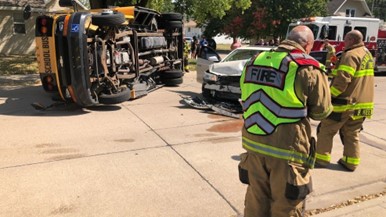Last week in my home state, a car hit a school bus broadside and turned it onto its side. Luckily, there were only three minor injuries. With schools back in full swing, it is a good time to remind drivers to use extreme caution around buses.
National School Bus Safety Week is from October 21-25, 2024. The U.S. Department of Transportation’s National Highway Traffic Safety Administration (NHTSA) is urging drivers to slow down and be aware of school buses in their communities. Although school buses are one of the safest modes of transportation, injuries and fatalities do occur outside of or near the buses. Most often, these tragedies happen because motorists have failed to slow down and obey the bus’s stop sign or follow local traffic laws.
Nationwide, passing a school bus when it is stopped is illegal and poses a deadly risk to bus riders and their caretakers. Drivers should always come to a complete stop when a school bus's stop-arm is extended and its red lights are flashing. From 2013 to 2022, there were 1.5 times more fatalities among pedestrians (169) than occupants of school buses (111) in school-bus-related crashes. A total of 111 school-age children (18 and younger) died in school-bus-related crashes during that period, whether as occupants of school buses or other vehicles, or while on foot or bike. Of these 111 deaths, 25 were children who were walking.
From 2000 to 2022, there were 55 fatalities in crashes involving a driver illegally passing a stopped school bus. Almost half of these fatalities (25) were pedestrians aged 18 years or younger. When a school bus’s red lights are flashing and the stop-arm is extended, drivers must slow down and come to a complete stop. This is not a suggestion — it’s the law. Yellow flashing lights indicate that the bus is preparing to stop to load or unload children, so motorists should begin to slow down and prepare to stop their vehicles. Motorists may only start moving again when the red flashing lights are turned off, the stop-arm is withdrawn, and the bus begins to move. School bus riders and their caretakers are relying on drivers to follow the law to keep them safe.
Respect the "Danger Zone"
The area around a school bus where children are at the highest risk is known as the “Danger Zone.” Specifically, this includes any area around the bus where the driver may not be able to see a child, making it particularly hazardous. The Danger Zone encompasses:
- 10 feet in front of the bus, where the driver may be too high up to see a child.
- 10 feet on either side of the bus, where a child may be in the driver’s blind spots.
- Behind the school bus.
For more information about school bus stop safety, please visit https://www.nhtsa.gov/road-safety/school-bus-safety#the-topic-bus-stop-safety
Have You and Your Employees “Bought” into Safety?
Years ago, after a driver safety meeting, a driver approached me and remarked that he already knew how to drive safely. He mentioned that he had not had any accidents and knew what to do in case of one, so he wondered why I was so persistent in emphasizing safety. I told him that the most important "sale" I could ever make is about his life and safety. You might not see the need for this message today, but tomorrow, next week, or next year, it could be too late. By committing to safety, your actions could help keep both yourself and others alive.
This is what it will cost you to “buy” into Safety:
- Two seconds to fasten your seat belt.
- Ten minutes for a thorough Pre-trip inspection.
- Ten seconds to make sure your mirrors are properly adjusted.
- Two seconds to shut off your cell phone before operating a motor vehicle.
- Eight hours to get proper rest.
- Thirty seconds to clean the trash from your vehicle at the end of your trip or route.
- Keep your mind on your driving.
- A fraction of a second to flip on your turn signal.
- Two minutes to walk around your entire vehicle while fueling or stopped to make sure it is in safe order.
- Leave on time and allow extra time for adverse weather conditions.
- Slowdown in poor weather conditions such as fog, rain, snow or ice.
- Increase your following distance.
- Expect the unexpected.









